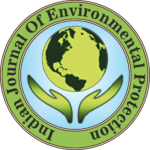IJEP 41(6): 663-667 : Vol. 41 Issue. 6 (June 2021)
Pravas Kumar Jee1 and Asoke Prasun Chattopadhyay2*
1. Geological Survey of India, Geo-environmental Laboratory, Kolkata – 700 016, West Bengal, India
2. University of Kalyani, Department of Chemistry, Nadia – 741 235, West Bengal, India
Abstract
Twenty five sub-surface soil samples collected from agricultural fields, used to cultivate local vegetables adjoining the open municipal solid waste dumpsite in Dhapa of Kolkata town, were analyzed for some heavy metals (Cu, Pb, Mn, Zn, Ni and Cr) using atomic absorption spectrophotometer. The analysis of the aqua regia digestion for total metal showed an average concentration of Cu (465.32±7.6 ppm), Pb (679.09±5.78 ppm), Mn (987.35±8.84 ppm), Zn (1982.37±10.52 ppm), Ni (67.39±4.21 ppm) and Cr (595.61±6.28 ppm). The concentration of Cr, Pb and Zn in the soil evolved from solid waste dumping was exceptionally high in comparison to the Indian compost standard. Sequential extraction studies were also carried out for the metals using Tessier method [1]. Most of the Cr, Pb and Ni were found to be associated with the residual fraction whereas Zn and Mn were more in the reducible phase. Cu was found to be present more in the oxidizable phase. The bioavailability order (sum of exchangeable and acid extractable phase) of metals was Ni > Mn > Pb > Zn > Cu > Cr. The recovery obtained by comparing the aqua regia extracted metal content with the sum of sequentially extracted fractions was in the range of 101–108%.
Keywords
Dhapa, Municipal solid waste, Heavy metals, Sequential extraction, Bioavailability
References
- Tessier, A. and P.G.C. Campbell. 1998. Metal speciation: Theory, analysis and applications. Ed J. R. Kramer and H. E. Allen. Lewis Publishers, Chelsea.
- USEPA. 2002. Municipal solid waste. Available at http://www.USEPA/municipalwaste/publication.net
- Lottermoser, W., et al. 1985. The toxic effects of solid wastes are known to be greatly influenced by their heavy metal contents.
- Das, A. K., et al. 1995. Metal speciation in solid matrices. Talanta. 42: 1007-1030.
- Sheppard, M. I. and M. Stevenson. 1997. Critical evaluation of selective extraction methods for soils and sediments. 3rd International Conference on Biogeochemical trace elements (Paris, France). Proceedings, pp 69-97.
- Filgueiras, A. V., I. Lavilla and C. Bendicho. 2002. Chemical sequential extraction for metal partitioning in environmental solid samples. J. Env. Monit., 4: 823-857.
- Kersten, M. 2002. Speciation of trace metals in sediments. In Chemical speciation in the environment (2nd edn). Ed A. Ure and C. M. Davidson. pp 301-321).
- Rao, C. R. M., A. Sahuquillo and J. F. L. Sancher. 2008. A review of the different methods applied in environmental geochemistry for single and sequential extraction of trace elements in soils and related materials. Water Air Soil Poll., 189: 291-333.
- Zimmerman, A. J. and D. C. Weindorf. 2010. Heavy metal and trace metal analysis in soil by sequential extraction: A review of procedures. Int. J. Analytical Chem. DOI: 10.1155/2010/387 803.
- Sebathian, E., et al. 2005. Assessment of heavy metal species in decomposed municipal solid waste. Chem. Speciation Bioavail., 17(3): 95-102. DOI: 10.3184/095422905782774883.
- EPTA. 2001. The effect of heavy metals on the environment and on health. Available at: https://eptanetwork.org/database/projects/37-heavy-metals.
- MoEF. 2000. Municipal Solid Waste (Management and Handling) Rules. Available at: https://cpcb.nic. in/municipal-solid-waste-rules.
- Backes, C. A., et al. 1995. Kinetics of cadmium and cobalt desorption from iron and manganese oxides. Soil Sci. Soc. American J., 59: 778-785.
- Staelens, N., P. Parkpian and C. Polprasert. 2000. Assessment of metal speciation evolution in sewage sludge dewatered in vertical flow reed beds using a sequential extraction scheme. Chem. Speciation Bioavail., 12: 97-107.
- McLaughlin, M. J., et al. 2000. Soil testing for heavy metals. Commun. Soil Sci. Plant Analysis. 31: 1661-1700.
- Ge, Y., P. Murray and W. H. Hendershot. 2000. Trace metal speciation and bioavailability in urban soils. Env. Poll., 107: 137-144.
